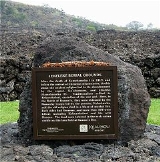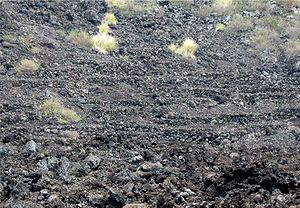
Kuamoo Burials
Encyclopedia
The Kuamoo Burials is an historic Hawaii
an burial site for warriors killed during a major battle in 1819. The site is located at Kuamoo Bay in the North Kona District, on the island of Hawaii
, United States
.
, after creating a united Kingdom of Hawaii
, followed the ancient Hawaiian Religion
called the Kapu
system.
When he died in May 1819, power passed to his wife Queen Kaahumanu and Kamehameha I's son Liholiho (Kamehameha II
) who abolished the kapu system, leaving Hawaii religionless; Christian
missionaries didn't reach Hawaii until the March 30, 1820.
However, Kamehameha I's nephew, Kekuaokalani, wanted to keep the kapu system.
Kekuaokalani was asked by the Chiefs of the Puna, Hamakua, Ka'u and Hilo Districts to lead their warrior armies in an armed rebellion to protect the traditions still honored by the Alii Chiefs and many of the common people. The original Hawaiian Kahuna Religion had also created the aristocratic prerogatives of the Ruling Class of Hawaiian society, which would also result in a disorganized classless society.
The traditionalists marched from Kaawaloa at Kealakekua Bay
and met the royal army headed by Kalanimoku
in an area also known as Lekeleke in December 1819.
Both sides in the battle at this site had muskets, but Kalanimoku had a small cannon mounted on a double canoe, cannons mounted on the late King Kamehameha Paiea I's small sailing vessel "Fair American," in addition to 16 cannons of the French Frigate L'Uranie (commanded by French Captain Freycinet) Liholiho had requested off-shore supporting the Royalists, which ultimately turned the tide of battle. Over 300 warriors were killed, including Kekuaokalani and his wife Manono, who were buried under the lava rocks cairns on the battlefield.
The rest of the Traditionalist followers of the old religion dispersed to the protection of the four High Chiefs of the Big Island of Hawaii who sponsored the Traditionalist rebellion. They were ultimately pardoned.
Within a year, American Christian Protestant Missionaries such as Asa Thurston and Hiram Bingham
arrived, and the culture was forever changed.
There has not been a battle of that size on the island since.
The battlefield is listed on the Hawaii register of historic places as site 10-37-1745,
and was added to the National Register of Historic Places
in 1974 as site 74000714.
The name comes from the Ahupuaa (traditional land division), point, and bay called Kuamoo just to the South where the battle actually took place.
It literally means "backbone" in the Hawaiian Language
.
The burial ground was called Lekeleke, on the border between the Ahupuaa of Keauhou and Honalo.
Just to the North of this site is the Keauhou hōlua
and historic Keauhou Bay
. The Battle of Kuamoo site was named after the Kahuna Prince son of King Kamehameha Paiea I, the Conqueror, who led the Traditionalist Army: Kai-iwi-kuamoo-kekuaokalani (aka "Kekuaokalani" aka "Kuamoo.)

Hawaii
Hawaii is the newest of the 50 U.S. states , and is the only U.S. state made up entirely of islands. It is the northernmost island group in Polynesia, occupying most of an archipelago in the central Pacific Ocean, southwest of the continental United States, southeast of Japan, and northeast of...
an burial site for warriors killed during a major battle in 1819. The site is located at Kuamoo Bay in the North Kona District, on the island of Hawaii
Hawaii (island)
The Island of Hawaii, also called the Big Island or Hawaii Island , is a volcanic island in the North Pacific Ocean...
, United States
United States
The United States of America is a federal constitutional republic comprising fifty states and a federal district...
.
History
Despite some contact with Europeans, Kamehameha IKamehameha I
Kamehameha I , also known as Kamehameha the Great, conquered the Hawaiian Islands and formally established the Kingdom of Hawaii in 1810. By developing alliances with the major Pacific colonial powers, Kamehameha preserved Hawaii's independence under his rule...
, after creating a united Kingdom of Hawaii
Kingdom of Hawaii
The Kingdom of Hawaii was established during the years 1795 to 1810 with the subjugation of the smaller independent chiefdoms of Oahu, Maui, Molokai, Lānai, Kauai and Niihau by the chiefdom of Hawaii into one unified government...
, followed the ancient Hawaiian Religion
Hawaiian religion
Hawaiian religion is the term used to describe the folk religious beliefs and practises of the Hawaiian people. It is unrelated to, though commonly confused with, the philosophy of Huna....
called the Kapu
Kapu
Kapu refers to the ancient Hawaiian code of conduct of laws and regulations. The kapu system was universal in lifestyle, gender roles, politics, religion, etc. An offense that was kapu was often a corporal offense, but also often denoted a threat to spiritual power, or theft of mana. Kapus were...
system.
When he died in May 1819, power passed to his wife Queen Kaahumanu and Kamehameha I's son Liholiho (Kamehameha II
Kamehameha II
Kamehameha II was the second king of the Kingdom of Hawaii. His birth name was Liholiho and full name was Kalaninui kua Liholiho i ke kapu Iolani...
) who abolished the kapu system, leaving Hawaii religionless; Christian
Christian
A Christian is a person who adheres to Christianity, an Abrahamic, monotheistic religion based on the life and teachings of Jesus of Nazareth as recorded in the Canonical gospels and the letters of the New Testament...
missionaries didn't reach Hawaii until the March 30, 1820.
However, Kamehameha I's nephew, Kekuaokalani, wanted to keep the kapu system.
Kekuaokalani was asked by the Chiefs of the Puna, Hamakua, Ka'u and Hilo Districts to lead their warrior armies in an armed rebellion to protect the traditions still honored by the Alii Chiefs and many of the common people. The original Hawaiian Kahuna Religion had also created the aristocratic prerogatives of the Ruling Class of Hawaiian society, which would also result in a disorganized classless society.
The traditionalists marched from Kaawaloa at Kealakekua Bay
Kealakekua Bay
Kealakekua Bay is located on the Kona coast of the island of Hawaii about south of Kailua-Kona.Settled over a thousand years ago, the surrounding area contains many archeological and historical sites such as religious temples, and was listed in the National Register of Historic Places listings on...
and met the royal army headed by Kalanimoku
Kalanimoku
William Pitt Kalanimoku was a High Chief who functioned similar to a prime minister of the Hawaiian Kingdom during the reigns of Kamehameha I, Kamehameha II and the beginning of the reign of Kamehameha III. He was called The Iron Cable of Hawaii because of his abilities.-Life:Kalanimoku was born ...
in an area also known as Lekeleke in December 1819.
Both sides in the battle at this site had muskets, but Kalanimoku had a small cannon mounted on a double canoe, cannons mounted on the late King Kamehameha Paiea I's small sailing vessel "Fair American," in addition to 16 cannons of the French Frigate L'Uranie (commanded by French Captain Freycinet) Liholiho had requested off-shore supporting the Royalists, which ultimately turned the tide of battle. Over 300 warriors were killed, including Kekuaokalani and his wife Manono, who were buried under the lava rocks cairns on the battlefield.
The rest of the Traditionalist followers of the old religion dispersed to the protection of the four High Chiefs of the Big Island of Hawaii who sponsored the Traditionalist rebellion. They were ultimately pardoned.
Within a year, American Christian Protestant Missionaries such as Asa Thurston and Hiram Bingham
Hiram Bingham I
Hiram Bingham, formally Hiram Bingham I , was leader of the first group of Protestant missionaries to introduce Christianity to the Hawaiian islands.-Life:...
arrived, and the culture was forever changed.
There has not been a battle of that size on the island since.
The battlefield is listed on the Hawaii register of historic places as site 10-37-1745,
and was added to the National Register of Historic Places
National Register of Historic Places
The National Register of Historic Places is the United States government's official list of districts, sites, buildings, structures, and objects deemed worthy of preservation...
in 1974 as site 74000714.
The name comes from the Ahupuaa (traditional land division), point, and bay called Kuamoo just to the South where the battle actually took place.
It literally means "backbone" in the Hawaiian Language
Hawaiian language
The Hawaiian language is a Polynesian language that takes its name from Hawaii, the largest island in the tropical North Pacific archipelago where it developed. Hawaiian, along with English, is an official language of the state of Hawaii...
.
The burial ground was called Lekeleke, on the border between the Ahupuaa of Keauhou and Honalo.
Just to the North of this site is the Keauhou hōlua
Keauhou Holua Slide
The Keauhou Hōlua Slide is located in Keauhou on the island of Hawaii. It is the largest and best-preserved hōlua course, used in the extremely dangerous toboggan-like activity restricted to the alii class of men, the nobility of ancient Hawaii. The remains are about long, of the original that...
and historic Keauhou Bay
Keauhou Bay
Keauhou Bay is a historic area in the Kona District of the Big Island of Hawaii.The name comes from ke au hou which means "the new era" in the Hawaiian Language.-Kamehameha III's Birthplace:...
. The Battle of Kuamoo site was named after the Kahuna Prince son of King Kamehameha Paiea I, the Conqueror, who led the Traditionalist Army: Kai-iwi-kuamoo-kekuaokalani (aka "Kekuaokalani" aka "Kuamoo.)


